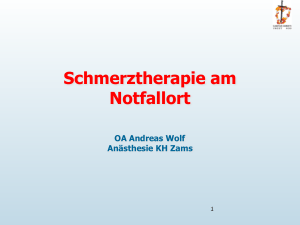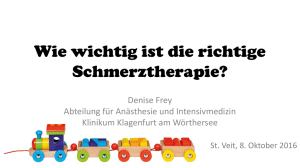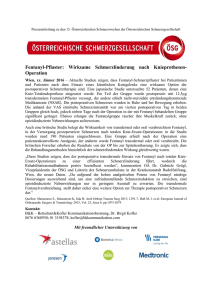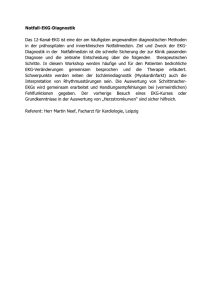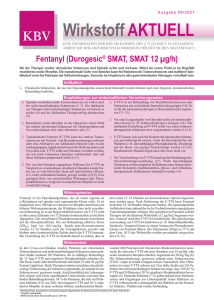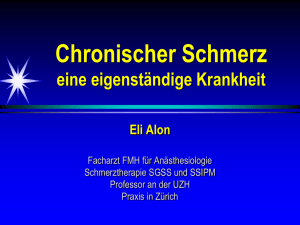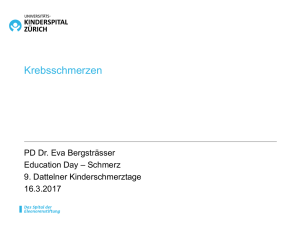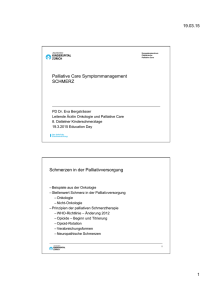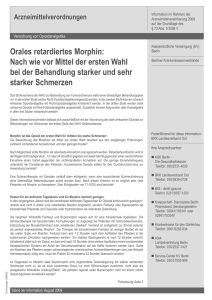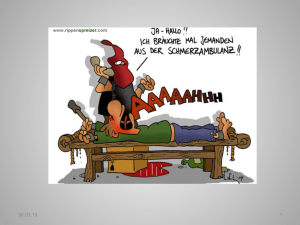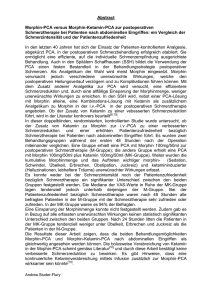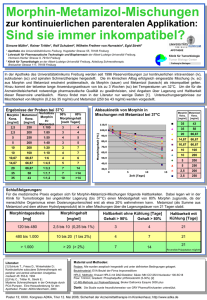Schmerztherapie am Notfallort
Werbung
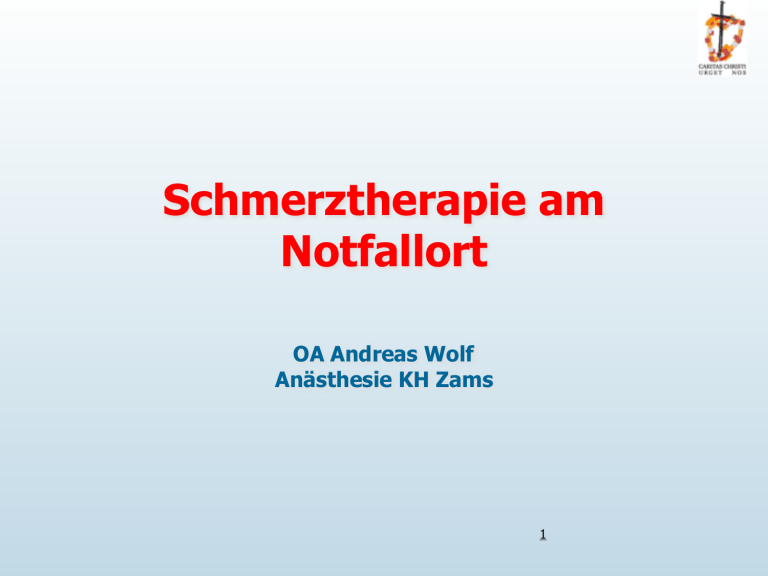
Schmerztherapie am Notfallort OA Andreas Wolf Anästhesie KH Zams 1 SCHOCKRAUMPATIENTEN JE JAHR 2400 1800 1200 600 2 2013 2012 2011 2010 2009 2008 2007 0 SCHOCKRAUMAUFNAHME JE UHRZEIT 200 2007 2008 2009 2010 2011 2012 2013 150 100 50 0 0 1 2 3 4 5 6 7 8 9 10 11 12 13 14 15 16 17 18 19 3 20 21 22 23 ANZAHL PAT JE ALTERSGRUPPE DIAGRAMM 1600 1200 800 400 0 O bis 10 11bis20 21 bis 30 31 bis 40 41 bis 50 51 bis 60 61 bis 70 71 bis 80 81 bis 90 4 91 bis 102 Schmidbauer W, Hasper D, Kerner T. Der geriatrische Patient im Rettungsdienst -­‐ Besonderheiten der notärztlichen Versorgung. Anästhesiol Intensivmed Notfallmed Schmerzther 2008 ; 3 : 196–202 5 50,0 % 37,5 % 25,0 % CHIRURGISCH GEBHILFE INTERN NEUROLOGISCH TRAUMATOLOGISCH 12,5 % 0,0 % 2007 2008 2009 2010 2011 6 2012 2013 TRANSPORTSYSTEME JE JAHR 1200 AERIAL1 AIRMED1 ALPIN1 C11 C12 C14 C7 MARTIN1 MARTIN4 MARTIN5 MARTIN7 NEF RK1 900 600 300 0 2088 2009 2010 2011 7 2012 8 9 ZIEL frühzeitige, suffiziente Schmerztherapie Verhinderung der Stressreaktion und Ausbildung des Schmerzgedächtnisses 10 Consensus guidelines 1. SAFE approach 2. Stop the burning process 3. Cooling 4. Covering/dressing 5. Assessment of AcBC* 6. Assessment of burn severity 7. Cannulation (and fluids) 8. Analgesia 9. Transport *ASSESSMENT AND MANAGEMENT OF IMMEDIATELY OR IMMINENTLY LIFE THREATENING PROBLEMS: AcBC (Airway with cervical spine stabilisation; Breathing, Circulation) Allison K, Porter K; Consensus on the prehospital approach to burns patient11 management; Emerg Med J 2004, 21:112-114 Häufigkeit analgetischer Behandlung bei verschiedenen präklinischen Diagnosen Stork B, Hofmann-­‐Kieler K. Analgesie in der Notfallmedizin. Notfall Rettungsmed 2008.11:427-­‐438 12 Hofmann-­‐Kiefer K, Praeger K, Buchfelder A etal. (1998) Präklinische Schmerztherapie an einem innerstädtischen Notarztstandort. Anästhesiologie und Intensivmedizin 7/8(39): 362–368 Acute Pain and Availability of Analgesia in the Prehospital Emergency Setting in Italy: A Problem to be Solved F. Marinangeli, ••*; C. Narducci, ••*; A. Paladini, ••*; Giustino Varrassi, ••* Pain Pract 2009; 9: 282-88 Department of Anesthesiology and Pain Treatment, University of L’Aquila; Italy 13 40 32,5 Patients (%) 30 26,5 22 20 12 10 3,25 3,75 0 Absent Slight Moderate Severe Unbearable Inaccurate Pain evaluation Patients’ assessment of pain 14 Results for ambulance services indicate that 10.6% did not have analgesics at all (including NSAIDs or paracetamol) and 11.5% were without opioids. In total, 88.5% of services had at least 1 opioid available (weak or strong), but only 79.8% had a strong opioid available 15 Changing attitudes about pain and pain control in emergency medicine Fosnocht et al, Emerg Med Clin North Am. 2005; 23: 297-306 An attitude of suspicion, a culture of ignoring the problem, and an environment that is not conducive to change in practice combine to present formidable obstacles for effective pain management in the emergency setting. Overcoming these obstacles for effective analgesia in the ED is not beyond the capabilities of the individual ED, the emergency physician, or the specialty of emergency medicine. To improve our treatment of pain in the ED, a fundamental change in attitude toward pain and the control of pain is required. This is unlikely to occur until pain is adequately addressed and treated appropriately as a true emergency 16 . Italy: why there is difference between the analgesics used in ambulances and helicopters? Pain treatment in Emergency Setting A problem of TRAINING…. 17 Schmerztherapie ist ein Problem in der Notfallmedizin Der angst- und schmerzfreie Patient ist ein primäres Ziel und eine verpflichtende Aufgabe in der Notfallmedizin 18 SCHMERZMESSUNG VAS: VRS: 0 = kein Schmerz, 10 = unerträglicher Schmerz 0 = kein Schmerz, 1 = leicht, 2 = mäßig, 3 = mittelstark, 4 = stark, 5 = sehr stark 0 - 10 NRS: 255 Pat. 60% VAS verwendet. Signifikanter Schmerz größer 3 Korrekt validiert – inadäquat behandelt (Angst vor Opioiden, keine Schmerzmessung) ZIEL: 1) 2) Vermeiden eines Schmerzgedächtnis Ricard-Hibon A, Leroy N, Magne M, Leberre A, Chollet C, Marty J. Evaluation of acute pain in prehospital medicine. Ann Fr Anesth Reanim 1997; 16(8): 945-9 Lewis LM, Lasater LC, Brooks CB. Are emergency physicians too stingy with analgesics? 19 SCHMERZMESSUNG Das Einschätzen der Schmerzen ist im Kindesalter of schwierig (Angst vor Trennung, Angst vor fremden Gesichtern) Schmerzeinschätzung: VAS (ab 6a) Smiley-Skala jünger als 6a Verhalten: Gesichtsausdruck, Körperhaltung, Weinen, Unruhe, physiologische Parameter, Schmerzursachen Schlechtriemen T, Bachmann D, Allemeyer K. Notfälle aus der Pädiatrie. In: Hempelmann G, Adams HA, Sefrin P (Hrsg): Notfallmedizin Stuttgart: Thieme 1999, 273-314. 20 Schmerzmedikamente i.v. Notarzt Ketoprufen, Metamizol Tramadol Morphin, Piritramid Fentanyl S-Ketamin 21 Nicht-medikamentöse Maßnahmen Psychologische Maßnahmen Lagerung Kryotherapie (Verbrennung) frühzeitige Reposition Kochs E, Krier C, Buzello W, Adams HA (Hrsg.): Anästhesiologie. Thieme 2001 22 Multimodale Analgesie Opioide in Kombination mit Nichtopioidanalgetika Nichtopioidanalgetika Coanalgetika - Regionalanästhesie 23 SEDOANALGESIE IN DER NOTFALLMEDIZIN • Körpereigene Peptide – verminderte Freisetzung von erregenden Neurotransmittern – Stabilisierung der postsynaptischen Membran der Hinterhornzellen – Aktivierung dämpfender Interneurone 24 Hauptwirkorte der Analgetika Schmerzwahrnehmung NSAR HautNozizeptoren Opioide HinterhornNeuron VorderSeitenstrang KonvergenzNeuron Viszerale Nozizeptoren 25 Antidepressiva / Antikonvulsiva/Ketamin 26 Kumle B, Wilke P, Koppert W et al. Schmerztherapie in der Notfallmedizin. Anaesthesist 2013 ·∙ 62:902–913 SEDOANALGESIE IN DER NOTFALLMEDIZIN • erhöhter Opioidbedarf: – starke Schmerzen bei stabilem Kreislauf • verminderter Opioidbedarf – Schock, Somnolenz jeden Notfallpatienten nach Opioidgabe kontinuierlich überwachen Cave: ATEMDEPRESSION / RR - Abfall 27 ANFORDERUNGSPROFIL ANALGETIKA • • • • • • Schneller Wirkungseintritt Schnelles Wirkmaximum Sichere Wirksamkeit Intravenöse Applikationsform Kurze bis mittelange HWZ Niedrige Allergierate 28 Opioid-ANALGETIKA • • • • • • • • Vendal - Morphinhydrochlorid Temgesic – Buprenorphin Alodan – Pethidin Dipidolor – Piritramid Tramal – Tramadol Fentanyl Ultiva – Remifentanil Nalbuphin – Nalbuphin - Hydrochlorid 29 • Analgesie – Fentanyl > Morphin > Piritramid > Tramadol • Sedierung – Piritramid > Morphin, Tramadol, Fentanyl • Atemdepressive Wirkung – bei gleicher analgetischer Wirkung: Fentanyl > Morphin > Piritramid > Tramadol • Übelkeit / Erbrechen – besonders stark ausgeprägt bei Tramadol 30 • Blutdrucksenkende Wirkung – besonders bei Hypovolämie Morphin,Pethidin > Piritramid, Fentanyl Tramadol • Histaminfreisetzung – vor allem bei Morphin und Pethidin – kaum bei Piritramid und Fentanyl • Bronchospastische Wirkung – gering ausgeprägt bei Piritramid und Fentanyl • Spasmogene Wirkung – am geringsten bei Pethidin 31 • starke Schmerzen • Frakturen • Contusionen • Polytrauma – MORPHIN 0, 1 mg / kg KG i. v. – FENTANYL 1 - 4 µg / kg KG ( 0, 1 - 0, 3 mg ) i. v. – PIRITRAMID 0, 1 - 0, 2 mg / kg KG i. v. 32 Results: A total of 259 patients were recruited. There were 123 patients in the metoclopramide group (age range 15–94 years; median age 53) and 136 patients in the placebo group (age range 17–93 years; median age 52.5). The overall incidence of nausea and vomiting in the whole study population was 2.7%, (1.6% in the metoclopramide group and 3.7% in the placebo group). The difference between the two groups was not statistically significant (Fisher’s exact test = 0.451; p = 0.3; z-test statistic = 1.02; 95% CI – 6% to 2%). Conclusion: When intravenous morphine is administered for acute pain, the overall incidence of nausea and vomiting is low, regardless of whether these patients are given prophylactic metoclopramide or not. Bradshaw M, Sen A; Use of a prophylactic antiemetic with morphine in acute pain: randomised controlled trial; Emerg Med J 2006; 23:210-213 33 Conclusion Morphine and fentanyl provided similar degrees of analgesia in this sample of patients treated for pain in the out-of-hospital setting, although this was achieved with a higher narcotic equivalent dose of fentanyl. Both medications had similarly low rates of adverse events that responded to basic paramedic interventions. Fleischmann et al.; Effectiveness and Safety of Fentanyl Compared with Morphine for 34 167-175 Out-of-Hospital Analgesia; Prehosp Emerg Care 2010 April 6 14(2): Dipidolor 15mg Piritramid • • • • Dipidolor 15mg ad KI 100ml 0,9% NaCl rascher Wirkeintritt ( 1- 2min.) Wirkdauer 4 – 6 Std. Cave Atemdepression bei schneller Infusion • NW: Bradycardie und Hypotonie 35 Hydal® Injektionslösung Dosierung Alter Bolus Infusion Erwachsene und Jugendliche (> 12 Jahre) Subkutane Anwendung (s.c.) 1 - 2 mg, alle 3 - 4 Stunden 0,15 - 0,45 mg/Stunde bzw. 0,004 mg/kg Körpergewicht/Stunde Intravenöse Anwendung (i.v.) 0.3 - 0.6 - 1,5 mg, alle 3 - 4 Stunden, langsam (mindestens 2 - 3 min) injizieren 0,15 - 0,45 mg/Stunde bzw. 0,004 mg/kg Körpergewicht/Stunde PCA (s.c. und i.v.) 0,2 mg Bolus bei einem Sperrintervall von 5 - 10 min Kinder (<12 Jahre) Nicht empfohlen 36 • Prospektive, randomisierte, doppelblinde Studie, 191 Patienten mit akuten starken Schmerzen wurden eingeschlossen. • Entweder erhielten sie Hydromorphon 0,015 mg/kg oder 0,1 mg/kg Morphin. Die mittlere Schmerzlinderung nach 30 min war mit i.v. Hydromorphon NRS 5,5 vs. NRS 4,1 mit i.v. Morphin. • Die Nebenwirkungen waren in beiden Gruppen ähnlich, nur Juckreiz trat mit Hydromorphon nicht auf. Schlussfolgerung: • Für die Behandlung von akuten, starken Schmerzen in der Notfallmedizin ist i.v. Hydromorphon mit 0,015 mg/kg eine Alternative zu i.v. Morphin mit 0,1 mg/kg KG. Chang AK, Bijur PE, Meyer RH, Kenny MK, Solorzano C, Gallagher EJ. Safety and Efficacy of Hydromorphone as an Analgesic Alternative to Morphine in Acute Pain: 37 A Randomized Clinical Trial. Annals of Emergency Medicine 2006; 48(2):164-172 • HERZINFARKT – MORPHIN 0, 1 mg / kg KG – NUBAIN 0, 15 - 0, 3 mg / kg KG ( 10 - 20 mg ) – MIDAZOLAM 1, 25 - 2, 5 mg Bolus ( titrieren ) Sedierung 0, 05 - 0, 1 mg / kg KG 38 Kolikschmerzen: Metoclopramid 10 mg und Metamizol i.v. (bis 2,5 g als Kurzinfusion) Butylscopolamin 20-40 mg i.v. Tramadol 100 mg (1-2mg/kgKG) mit Metamizol und Metoclopramid i.v. als Kurzinfusion Morphin (Nicomorphin = Vilan®) 10 mg in KI (Metamizol + Metoclopramid) bzw. langsam i.v. Hempelmann G, Adams HA, Sefrin P. (Hrsg.) Notfallmedizin, Stuttgart. Thieme 39 1999 Neue DBS - Therapieoptionen 1998 Oral trans -mucosal fentanyl citrate OTFC Actiq Transmukosal) 2009 2006/2008 FENTORA®(US)/ EFFENTORA™(EU) Effervescent Buccal Tablette ONSOLIS™ (US) FBSF In USA auf dem Markt Fentanyl Buccal Mukoadhäsives Plättchen 2008 Rapinyl™/ Abstral (EU) SLF Sublingual Fentanyl 2009 Instanyl™ (EU) INFS Intranasal Fentanyl 40 Spray 2009 NasalFent ® (EU) FPNS Fentanyl Pectin Nasal Spray EffentoraTM: Individualisierung der Durchbruchschmerz-Therapie Für die individuelle Behandlung der Durchbruchschmerzen steht Effentora™ in 5 Wirkstärken zur Verfügung Jede Packung Effentora™ ist mit einem Farbcode versehen 41 Intranasal and IV Fentanyl: Pharmacokinetics Plasma concentration–time curve: 100 µg intranasal and intravenous fentanyl Mean plasma fentanyl concentration, ng/ml (SD) IV IN 3,0 • Median time to meaningful pain relief : 7 min 2,5 • Duration of analgesia: 56 min (49 min i.v.) 2,0 • Tmax : 13 min (6 min i.v.) • Bioavailability: 89% 1,5 1,0 0,5 Mean ± standard deviation; n=7 0,0 0 45 90 135 Time after study drug administration (minutes) 42 Christrup et al. Clin Ther 2008; 30 (3): 469–481 180 INSTANYL® – Fakten zum Produkt • Indikation1 – Instanyl® ist für die Behandlung von Durchbruchschmerzen bei Erwachsenen bestimmt, die bereits eine Opioid-Basistherapie gegen ihre chronischen Tumorschmerzen erhalten. • Art und Inhalt des Behältnisses1 – Nasenspray: braune Glasflasche mit Dosierpumpe und Schutz- kappe in einer kindergesi- cherten Verpackung. – Klare, farblose Lösung (enthält Fentanylcitrat) 43 1 Fachinformation Instanyl®, Stand 07/2009 Es sollten aufgrund der Daten der hier vorliegenden Untersuchung folgende Faktoren zumindest in Zukunft diskutiert werden, damit eine patientenorientierte notfallmedizinische Versorgung von Patienten am Lebensende möglich ist: •frühzeitige Strukturierung der häuslichen Versorgung mithilfe der spezialisierten ambulanten Palliativversorgung sowie der ambulanten palliativmedizinischen Basisversorgung, •intensive Kooperation und Schulung aller an der Patientenversorgung beteiligten Personen und medizinischen Fachgebiete, •erweiterte Aus-­‐und Fortbildung der Rettungsdienstmitarbeiter sowie •Nutzung von Alternativen in der medikamentösen Applikation zur Therapie von Durchbruchschmerzen im Notarzteinsatz (beispielsweise oral/ transnasal). 44 Wiese CHR, Strumpf M, Löffler EK. Notärztliche Behandlung akuter Schmerzexazerbationen bei ambulanten Palliativpatienten in Deutschland Retrospektive multizentrische Untersuchung. Notfall Rettungsmed 2010 ·∙ 13:781–788 Funktion: COX-1 u. COX-2 Arachidonsäure COX-1 COX-2 COX-2 X X X X X (konstitutiv) z.B. (konstitutiv) Konventionelle NSAR Magenprobleme ! Nierendurchblutung " Thrombozytenaggregation " (induzierbar) z.B. Selektiver COX-2Inhibitor Entzündung " Entzündung Schmerz Schmerz " Nierendurchblutung " Wundheilung " 45 Nicht-Opioide Wirkspektrum analgetisch antipyretisch antiphlogistisch spasmolytisch NSAR XX X XXX --- Coxibe XX X XXX --- Metamizol XXX XXX (X) XX Paracetamol XX XX --- --- Flupirtin --- --- --- XX 46 Nicht-Opioidanalgetika Bolusintervall Maximaldosis pro Tag pro 70 kgKG i.v. – – – – Diclofenac 75 mg Ketoprofen 100 mg Lornoxicam 8 mg Parecoxib 40 mg – Metamizol 1000 mg – Paracetamol 1000 mg 6–12 h 6–8 h 6–8 h 12 h 4-6 h 6h 200 mg 300 mg 24 mg 80 mg 6000 mg 4000 mg 47 NSAR Voltaren, Neo Dolpasse, Xefo hauptsächlich periphere Wirkung entzündungshemmend cave: Thrombozytenfunktionsstörung Nierenfunktionsstörungen gastrointestinale NW (Magenschutz!) nicht geeignet für akutes Trauma Leberfunktionsstörungen kardiovaskuläre Erkrankungen (inkl. schwere Hypertonie) lt. FDA allergische Reaktionen ASS induziertes Asthma 48 Acetylsalicylsäure Aspisol periphere Wirkung irreversible Thrombozytenhemmung Hauptindikation: akutes Koronarsyndrom 250 – 500mg i.v. 49 Spasmolytika und Nierenbeckendruckwerte Metamizol N=9 Indometacin N=8 Butylscopolamin N=9 Intrapelv. Druck vorher [mmHg] 21,1 ± 4,9 14,6 ± 0,7 16,3 ± 3,2 Intrapelv. Druck nachher [mmHg] 16,6 ± 5,1* 9,1 ± 2,3** 15,0 ± 3,7!! * p ≤ 0,05, ** p ≤ 0,01 Metamizol und Indometacin in dieser „Ministudie“ wirksamer als Butylscopolamin! 50 Zwergel U et al., Schmerz (1998) Nicht-Opioide Metamizol - Indikationen ▪ Krampfartige Schmerzen bei Erkrankungen der Gallen- und Harnwege ▪ ▪ ▪ Postoperative Schmerztherapie Tumorschmerzen Fieber 51 Metamizol Nebenwirkungen Blutdruckabfall bei schneller i.v.-Gabe: ausschließlich als Kurzinfusion bzw. über Perfusor applizieren ! Agranulozytose (Warnzeichen: Fieber, Nekrosen und Geschwüre) 52 Aplastische Anämie - Metamizol Prospektive Studie zur Erfassung der Inzidenz der Agranulozytose bei oraler Einnahme in Polen. ▪ 15 Millionen Einwohner ▪ Beobachtungszeitraum: 12 Monate ▪ Verbrauch: 112.300.094 Tabletten ▪ 16 Fälle von Agranulozytosen (alle metamizolunabhängig) ▪ 27 Fälle aplastischer Anämien (2 x metamizolbedingt) Schlussfolgerung: ▪ Inzidenz der aplastischen Anämie = 0,25 pro 1 Million Personen pro Behandlungstag 53 Maj, S., Centkowski, P. Med Sci Monit (2004) 10:193-195 Paracetamol Vermutete Wirkmechanismen – Hemmung der zentralen Prostaglandin-H2-Synthase – Interaktion mit der enzymatischen NO-Synthese – Beeinflussung des serotoninergen inhibitorischen Systems (keine Rezeptor-Bindung) Orale Dosierung: 60 mg/kg/d, max: 4 g/d Vorsicht bei Leberfunktionsstörungen 54 Paracetamol Indikationen ▪ Leichte bis mittelstarke Schmerzen ▪ Allergie auf NSAR ▪ Fieber Kontraindikationen ▪ Leberschädigung ▪ Alkoholismus ▪ Glucose-6-Phosphatdehydrogenasemangel 55 Zusammenfassung Nichtopioidanalgetika spielen in der Notfallmedizin eine untergeordnete Rolle ➢ kein Einsatz bei akutem Trauma ➢ sinnvoll bei Koliken – v.a. Novalgin ➢ sinnvoll bei Migräne – NSAR, evt. Perfalgan ➢ akute Lumbalgie ➢ differenzierter Einsatz cave Begleiterkrankungen cave Begleitmedikamente 56 SEDOANALGESIE IN DER NOTFALLMEDIZIN • KETAMIN – Indikationen • Starke Schmerzen insbesondere traumatischer Genese • Narkoseeinleitung und - aufrechterhaltung meist in Kombination mit Benzodiazepinen • Analgesie und Narkose in unübersichtlichen Situationen • schwerer Asthmaanfall 57 SEDOANALGESIE IN DER NOTFALLMEDIZIN • KETAMIN – in niedriger Dosierung – in hoher Dosierung stark analgetisch narkotisch • erzeugt sog. dissoziative Anästhesie • Bewusstsein erloschen • erhaltene Spontanatmung • weitgehend erhaltene Schutzreflexe • Blutdrucksteigerung 58 SEDOANALGESIE IN DER NOTFALLMEDIZIN • KETAMIN – Weitere Wirkungen •Sympathikotone Wirkungen •Bronchodilatation •Hirndrucksteigerung (bei Spontanatmung) •Alpträume und Halluzinationen 59 Ketamin und ICP Frühere Aussagen: • erhöht CBF und führt daher zu ICP-Anstieg • beeinträchtigt die cerebrovaskuläre Autoregulation • wirkt epileptogen 60 Ketamin und ICP Diese Aussagen wurden widerlegt! The influence of ketamine on both normal and raised intracranial pressure of artificially ventilated animals. Pfenninger E, Dick W, Ahnefeld FW. Eur J Anaesthesiol 1985 Sep;2(3):297-307 Ketamine decreases intracranial pressure and electroencephalographic activity in traumatic brain injury patients during propofol sedation. Albanese J, Arnaud S, Rey M, Thomachot L, Alliez B, Martin C. Anesthesiology 1997 Dec; 87(6):1328-34 61 S - Ketamin & Hirndruck • Ketamin galt lange Zeit wegen möglichem Anstieg des ICP als „kontraindiziert bei Patienten mit SHT“ • diese Untersuchungen wurden alle bei spontan atmenden Patienten gemacht (1975-1980) ABER: • Bei konstantem pCO2 und konstantem MAP kein Anstieg des ICP nachweisbar1,2 1 Pfenninger et al, Notfallmedizin 1987; 13:472-477 2 Mayberg et al, Anesth Analg 1995; 81:84-89 62 Schlussfolgerung • Ketamin ist sicher und effektiv. • Ketamin ist sicherer als Midazolam und Propofol, was die Inzidenz von Apnoe oder Hypoxie betrifft. Vardy JM, Dignon N, Mukherjee N, Sami DM, Balachandran G, Taylor S. Audit of the safety and effectiveness of ketamine for procedural sedation in the emergency department. Emerg Med J 63 2008; 25:579-582 • Ketamin wurde bei 40 Patienten im Alter von 2 Monaten bis 75 Jahren verwendet. • 23 Patienten waren Traumapatienten, 4 Patienten hatten Verbrennungen, 4 Patienten hatten cardiale Notfälle und 9 Patienten waren andere medizinische Notfälle - meistens mit akuter respiratorischer Insuffizienz. Die meisten Patienten erhielten eine Dosis Ketamin, 12 Patienten bekamen wiederholte Dosierungen. Die Dosierung von Ketamin war zwischen 1 mg/kg i.v. und 5 mg/kg i.m. Schlussfolgerung: Ketamin ist eine ideale Substanz für die Verwendung in prähospitaler Situation, ist sicher und effektiv. Svenson JE, Abernathy MK. Ketamine for prehospital use: new look at 64an old drug. American Journal of Emergency Medicine 2007; 25:977-980 Eingeklemmte Person - Alpineinsatz S-Ketamin: i.v. (0,125-0,25 mg/kg KG) oder i.m. 0,25-0,5 mg/kg/KG bei nicht gesichertem Atemweg – Midazolam wegen Atemdepression vermeiden 65 Dosierungen von S-Ketamin Indikation Analgesie Applikationswert (jeweils in mg/kg KG) i.v. i.m. buccal rektal nasal 0.125 – 0.25 0.25 – 0.5 1.0 – (2-4) 0.5 – 1.0 (2-4) 0.5 (2-4) 1.0 (2-4) 2.0 (bis 4) 2.0 (bis 4) 0.5 mg/kg/ Analgosedierung h (0.3 – 1.0 (bis 4) 1.5) + Midazolam 0.5 mg/kg Anästhesie 1.0* 2.5 (bis 4) Katastrophenmedizin: 0.1 mg/kg KG sc. (kont.) + Midazolam 0.1 mg/kg * zur Aufrechterhaltung: 2 mg/kg KG/h oder 0.5 mg/kg KG alle 15 min. Die Werte sind die vom Hersteller empfohlenen. Die Dosierung in den Klammern entsprechen den Erfahrungen aus der Praxis und werden von den Experten als Dosisbereiche jenseits der Herstellerangaben empfohlen. 66 Experten-Statement S-Ketamin. Wirkung und klinische Indikation. Vorteile von S(+)-Ketamin im präklinischen Einsatz • Gute Analgesie, schwache hypnotische Eigenschaften • Große therapeutische Breite • Keine Organtoxizität • Erhaltung der Spontanatmung • Erhaltung der Schutzreflexe (ohne Gewähr, dass sich Aspiration vermeiden lässt) • Zentrale Sympathikusstimulation • Broncholytische Wirkung • Unterschiedliche Applikationswege (oral, sublingual, rektal, i.v., i.m., s.c., rückenmarksnah) • Unterliegt nicht dem Suchtmittelgesetz • Geringer logistischer Aufwand • Hohe Sicherheit • Schneller Wirkungseintritt • Relativ gute Steuerbarkeit 67 Results: Mean treatment time 46 ± 17 minutes in the M-group and 56 ± 11 minutes in the MKgroup, respectively (ns). Mean doses of morphine sulphate in the M-group were 13.5 ± 3.2 mg versus 7.0 ± 1.5 mg in the MK-group. The mean additional doses of ketamine in the MK-group were 27.9 ± 11.4 mg. There were significantly differences between the M- and the MK-group according to NRS scores for pain (5.4 ± 1.9 versus 3.1 ± 1.4) and BP (134 ± 21 mmHg versus 167 ± 32 mmHg) at admission at hospital, respectively (P < 0.05). All patients were Alert or respond to Voice and the results were similar between the groups. One patient versus 4 patients reported nausea in the M- and MK-group, respectively, and 3 patients vomited in the Mk-group (ns). Conclusion: We conclude that morphine sulphate with addition of small doses of ketamine provide adequate pain relief in patients with bone fractures, with an increase in systolic blood pressure, but without significant side effects. Johansson et al; The effect of combined treatment with morphine sulphate and low-dose ketamine in a prehospital setting; Scandinavian Journal of Trauma, 68 Resuscitation and Emergency Medicine 2009 Ketanest – S: Klinische Indikationen 1. Präklinischer Notfall – u. Katastropheneinsatz • schwierige Bedingungen • hohes Narkoserisiko (Vitalfunktionen↓,Aspirationsgefahr) • Polytrauma – Patienten • Status asthmaticus KETANEST–S ist aus dem Notarzt-Ampullarium vor dem Hintergrund dieser Probleme NICHT WEGZUDENKEN ! 69 Schlussfolgerung • S-Ketamin i.v. oder i.m. ist sicher und effektiv • Zukunftsvision: Ketamin oral • Neuropathische Schmerzen müssen entsprechend Guidelines so früh wie möglich therapiert werden. Experten-Statement S-Ketamin. Wirkung und klinische Indikation. 70 CONCLUSION - Livopan Fifty per cent nitrous oxide has previously been shown to have similar efficacy for pain relief for a range of procedures compared to conventional analgesia with intravenous analgesic regimens, including opioid analgesia. This review has shown that side effects are uncommon and major adverse events such as hypotension and oxygen desaturation could not be attributed to nitrous oxide inhalation. Recovery from sedative effects of nitrous oxide is faster compared with intravenous analgesia. Nitrous oxide at a concentration of 50% is an effective and safe form of analgesia. The side effect profile of this agent suggests that it could be used safely by adequately trained lay persons in the prehospital setting. Faddy SC; Garlick SR; A systematic review of the safety of analgesia with 71 50% nitrous oxide: can lay responders use analgesic gases in the prehospital setting?; Emerg Med J 2005, 22:901-906 In addition, the recent experiences of the military have shown promising results in trauma patients with the early use of regional anesthesia, especially continuous catheter techniques, after injury and during transport. It is likely that this experience will be transferred into the civilian sector in the coming years, including continuous catheters for longer-term analgesia. It is important for anesthesiologists to take the lead in adapting regional anesthesia techniques outside of the operating room environment and introduce them into the emergency room and prehospital care setting. Wu JJ, Lollo L, Grabinsky A; Regional Anesthesia in Trauma Medicine; Anesthesiology 72 Research and Practice Volume 2011, Article ID 713281 Lokalanästhesie Verfahren der Lokal-­‐ und Regionalanästhesie sind wegen der Komplexität der Anlagetechnik, der oftmals nicht vorhandenen Materialien und des verzögerten Wirkeintritts in Notfallsituationen letztlich weitgehend ohne Bedeutung und werden im Rahmen dieses Artikels nicht näher beschrieben. Einzig der Fascia-­‐iliaca-­‐Block wird in der Literatur als mögliches Regionalverfahren in der Notfallsituation beschrieben 73 in prehospital care. Reg Lopez S, Gros T, Bernard N etal. (2003) Fascia iliaca compartmentblock for femoral bone fractures Anesth Pain Med 28: 203–207 Fascia illiaca block Suprascapsularis block 74 Schlussfolgerung • Zusammenfassend ist zu sagen, dass die Regionalanästhesie im Notfallbereich einen gesicherten Patz hat, dieser ist jedoch nicht am Unfallort zu suchen, sondern innerhalb der Abteilungen in denen die Erstversorgung der Akutfälle stattfindet. 75 SEDOANALGESIE IN DER NOTFALLMEDIZIN • Basis der Schmerztherapie – – – – ruhiger konzentrierter problemorientierter sachlicher Arzt ÄNGSTE mindern ANALGESIE Sedierung 76 z.B.: unser NEF-System in Zams 77 Schmerztherapie in der Notfallmedizin ist kein "Problem" sondern PFLICHT 78 Danke für Ihre Aufmerksamkeit 79
